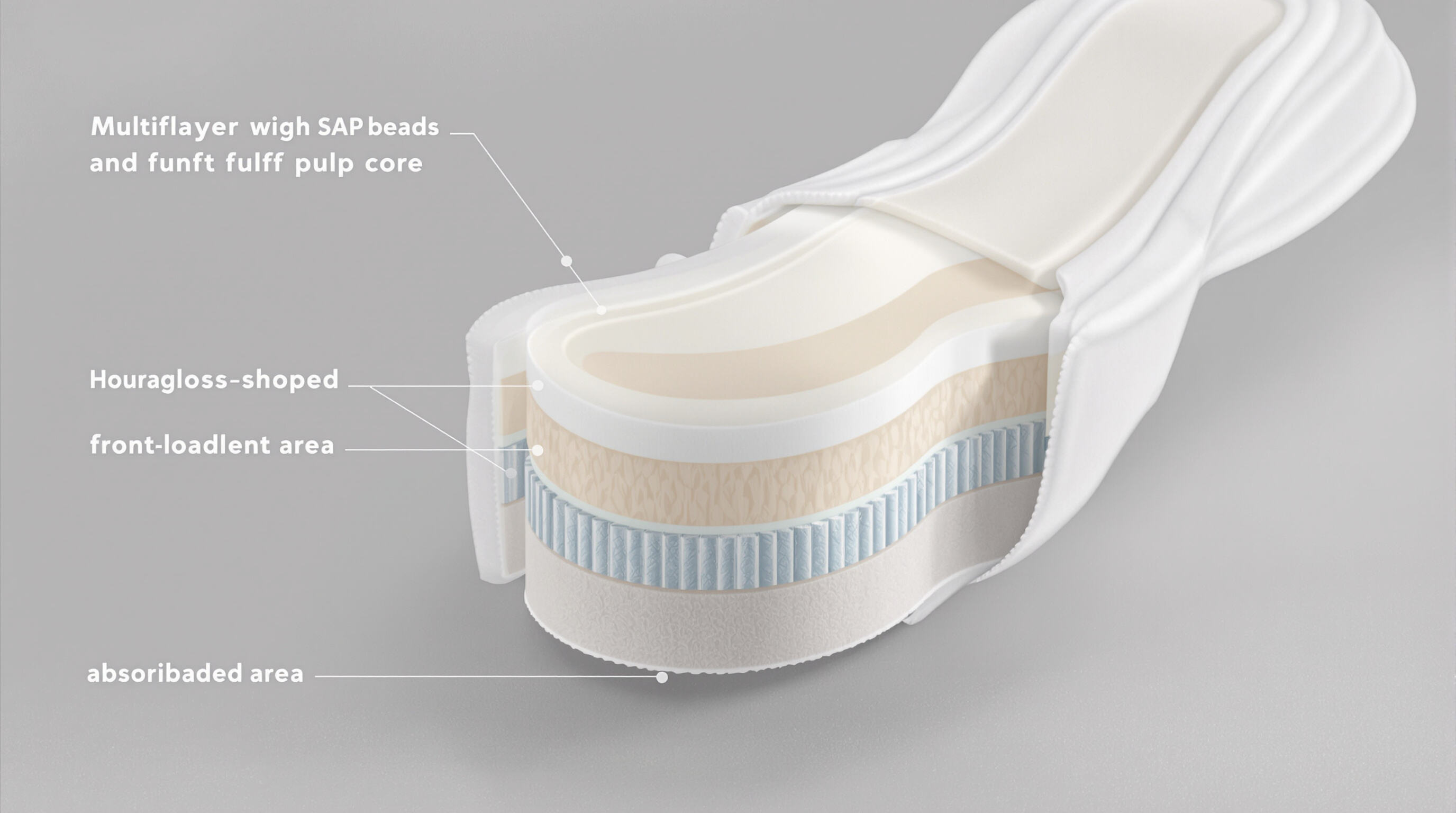ແມ່ແບບການຂໍເອົາລາຄາສຳລັບການຊື້ຜ້າອ້ອມກາງຄືນທີ່ມີການວາງຊັ້ນໃນແບບກາງຄືນ
ການເຂົ້າໃຈຜ້າອ້ອນໃຊ້ແລ້ວປ່ຽນທີ່ອອກແບບມາສໍາລັບການນອນຄືນ: ການອອກແບບ, ໜ້າ ທີ່, ແລະ ຄວາມຕ້ອງການດ້ານການປະຕິບັດງານ
ການກໍານົດຜ້າອ້ອນໃຊ້ແລ້ວປ່ຽນທີ່ອອກແບບມາສໍາລັບການນອນຄືນ ແລະ ຄວາມຕ້ອງການດ້ານການປະຕິບັດງານທີ່ເປັນເອກະລັກຂອງມັນ
ຜ້າອ້ອນທີ່ຖືກອອກແບບມາສໍາລັບການໃຊ້ໃນຕອນກາງຄືນມາພ້ອມກັບຄຸນສົມບັດພິເສດເພື່ອໃຫ້ສາມາດນອນໄດ້ຕະຫຼອດຄືນ. ຜ້າອ້ອນເຫຼົ່ານີ້ມັກຈະຍາວກ່ວາຜ້າອ້ອນປົກກະຕິຫຼາຍ, ປົກກະຕິແລ້ວມີຄວາມຍາວປະມານ 30 ຫາ 40 ຊັນຕີແມັດ, ພ້ອມທັງມີຊັ້ນປ້ອງກັນການຮົ່ວໄຫຼເພີ່ມເຕີມພ້ອມທັງຊັ້ນທີ່ຊຶມຊັບດີເພື່ອຮັບມືກັບການມາປະຈໍາທີ່ຫຼາກຫຼາຍ. ຜ້າອ້ອນໃຊ້ຕອນເຊົ້າບໍ່ສາມາດໃຊ້ໄດ້ເມື່ອໃຜກໍຕາມຕ້ອງການຜ້າອ້ອນທີ່ສາມາດຮັກສາຄວາມແຫ້ນຫາໄດ້ຢ່າງໜ້ອຍ 8 ຊົ່ວໂມງຫຼືຫຼາຍກວ່ານັ້ນໃນຂະນະທີ່ກາຍກາຍຕົວຢູ່ໃນຕຽງ. ຜູ້ຜະລິດໃຫ້ຄວາມສໍາຄັນເປັນອັນດັບໜຶ່ງໃນການປ້ອງກັນການຮົ່ວໄຫຼຂ້າງ, ຈາກນັ້ນແລ້ວຈຶ່ງແນ່ໃຈວ່າວັດສະດຸສາມາດລົມໄດ້ດີເພື່ອບໍ່ໃຫ້ຜິວໜັງແພ້ຈາກການຄົງຄ້າງຂອງຄວາມຊຸ່ມຊື່ນຕະຫຼອດຄືນ. ຍັງມີເຕັກໂນໂລຊີທີ່ຖືກຝັງເຂົ້າໄປເພື່ອຄວບຄຸມກິ່ນເຊິ່ງຊ່ວຍໃຫ້ແມ່ຍິງຮູ້ສຶກສະດວກສະບາຍແລະໝັ້ນໃຈຫຼາຍຂຶ້ນເຖິງແມ່ນວ່າຈະຕື່ນຂຶ້ນມາໃນຕອນເຊົ້າ.
ການອອກແບບແກນແລະການກໍ່ສ້າງຜ້າອ້ອນສໍາລັບຄວາມສະດວກໃນການໃຊ້ງານໃນໄລຍະຍາວແລະການປ້ອງກັນການຮົ່ວໄຫຼ
ຜ້າອ້ອນຕອນກາງຄືນທີ່ມີປະສິດທິພາບສູງນໍາໃຊ້ການກໍ່ສ້າງຫຼາຍຊັ້ນທີ່ຖືກອອກແບບມາເພື່ອຄວາມຍືນຍົງແລະຄວາມສະດວກສະບາຍ:
- ກ ຊັ້ນໜ້ານຸ່ມ , ມັກຈະເຮັດມາຈາກວັດສະດຸທີ່ບໍ່ແມ່ນເສັ້ນໃຍຫຼືເນື້ອຜ້າອ້ອຍ, ຮັບປະກັນໃຫ້ແຫຼວຊັບໄດ້ຢ່າງໄວວາ
- ກ ໂພລີເມີດູດຊືມສູງ (SAP) ກາງໃຈ ຄລະກະສົມກັບເສັ້ນໃຍປວກຢ່າງໄວວາປ່ຽນແຫຼວເປັນເຈວ, ປ້ອງກັນການຊຸ່ມຄືນ
- ຕອບສະຫນອງການກັ້ນໄຫຼ 3D ຕ້ອງມີຂອບເພື່ອຊ່ວຍກຳນົດທິດທາງຂອງແຫຼວໄປຫາສ່ວນກາງ
- ກ ຜ້າຫຸ້ມຫຼັງທີ່ລົມລະອອງໄດ້ ໃຫ້ການກັນນ້ຳໄດ້ໃນຂະນະທີ່ອະນຸຍາດໃຫ້ຄວັນລະເຫີຍຜ່ານ
ຊັ້ນເຫຼົ່ານີ້ຖືກປັບປຸງເພື່ອໃຫ້ສາມາດຕ້ານທານຕໍ່ກົດດັນຕໍ່ເນື່ອງຈາກການນອນ, ມີອັດຕາການຟື້ນຕົວຈາກການອັດຕັດຫຼາຍກ່ວາ 90% ຫຼັງຈາກໃຊ້ເວລາ 8 ຊົ່ວໂມງ (ການທົດສອບການດູດຊືມ, 2023).
ການຈັບຄູ່ລະດັບການດູດຊືມກັບຄວາມຕ້ອງການຂອງຜູ້ໃຊ້ໃນຜ້າອ້ອມກາງຄືນ
ຜ້າອ້ອນທີ່ໃຊ້ໃນຕອນກາງຄືນສາມາດຮັບໄດ້ຕັ້ງແຕ່ປະມານ 8 ມິນລີລິດ ຫາ 25 ມິນລີລິດຂອງແຫຼວ, ແຕ່ຜູ້ຜະລິດໂດຍທົ່ວໄປຈະແບ່ງອອກເປັນ 3 ປະເພດຫຼັກຄື: ຄວາມອາດສາມາດໃນການຊຶມຊັບຕ່ຳປະມານ 6 ຫາ 10 ມິນລີລິດ, ປະເພດທຳມະດາປະມານ 11 ຫາ 15 ມິນລີລິດ ແລະ ປະເພດທີ່ຮັບໄດ້ຫຼາຍເລີ່ມຕັ້ງແຕ່ 16 ມິນລີລິດຂຶ້ນໄປ. ຕາມການສຳຫຼວດຕະຫຼາດທີ່ຜ່ານມາໃນປີກ່ອນ, ຜູ້ຍິງທີ່ຖືກສຳຫຼວດເກືອບສອງສ່ວນສາມໃຫ້ຄວາມສຳຄັນກັບການຄົງຄ້າງໄວ້ໃນສະພາບແຫ້ງກ່ວາການມີຜະລິດຕະພັນທີ່ບາງຫຼາຍ. ຂໍ້ມູນນີ້ໄດ້ສົ່ງເສີມໃຫ້ເກີດການພັດທະນາທີ່ຫນ້າສົນໃຈໃນການກຳນົດວິທີການແຜ່ກະຈາຍວັດສະດຸ SAP ໃນຜິວໜ້າຂອງຜ້າອ້ອນ. ຮູບແບບໃໝ່ໆສຸມໃສ່ການໃຊ້ໂພລີເມີຣ໌ຊຶມຊັບໃນບໍລິເວນທີ່ມັກຈະຮົ່ວໄຫຼຫຼາຍຂຶ້ນປະມານ 20 ສ່ວນຮ້ອຍ, ແຕ່ຍັງສາມາດຮັກສາຄວາມຫນາທັງໝົດໃຫ້ຕ່ຳກ່ວາ 8 ມິນລີລິດເພື່ອບໍ່ໃຫ້ຮູ້ສຶກວ່າໜັກເວລາໃສ່.
ເທກໂນໂລຊີໃຈກາງຊຶມຊັບ: SAP, ເສັ້ນໃຍປວກ (Fluff Pulp), ແລະ ການວາງໃຈກາງຢ່າງມີຍຸດທະສາດ

ບົດບາດຂອງໂພລີເມີທີ່ດູດຊຶມນ້ຳສູງ (SAP) ຕໍ່ການປະຕິບັດງານຂອງຜ້າອ້ອມທີ່ມີຄວາມອາດສາມາດສູງໃນການໃຊ້ຂ້າມຄືນ
ຄວາມລັບທີ່ຢູ່ເບື້ອງຫຼັງຜ້າອ້ອມທີ່ດີໃນການໃຊ້ຕອນກາງຄືນແມ່ນຢູ່ໃນສິ່ງທີ່ເອີ້ນວ່າ ໂພລີເມີ່ທີ່ຊັບຊ້ອນສູງ (SAP). ວັດຖຸດິບພິເສດເຫຼົ່ານີ້ສາມາດດູດຊຶມໄດ້ຫຼາຍກ່ວາຝ້າຍທຳມະດາ ຫຼື ເຊລູໂລສະຖານະພາບປະມານ 30 ເທົ່າ. ເມື່ອນ້ຳເດືອດຕົກໃສ່ມັນ, ເຈນໂຄຣສລິງຄ໌ຈະດູດຊຶມຢ່າງໄວວາ ແລະ ປ່ຽນທຸກຢ່າງໃຫ້ກາຍເປັນສານເຈນທີ່ຄ້າງຕົວ. ນີ້ໝາຍຄວາມວ່າແມ່ຍິງຈະຮູ້ສຶກແຫ້ງດີຕະຫຼອດຄືນຍາວເມື່ອພວກເຂົາຕ້ອງການການປົກປ້ອງຈາກເວລາ 20:00 ໂມງຈົນເຖິງເຊົ້າມື້ຕໍ່ໄປ. ການສຶກສາໃນປີ 2020 ໄດ້ສະແດງໃຫ້ເຫັນເຖິງຄວາມສາມາດອັນເຫຼືອເຊື່ອຂອງ SAP ເຊິ່ງບາງຊະນິດສາມາດເກັບຮັກສາຂອງແຫຼວໄດ້ຫຼາຍກ່ວານ້ຳໜັກຂອງຕົນເອງເຖິງ 300 ເທົ່າ. ນັ້ນແມ່ນເຫດົນຜູ້ຜະລິດຈຶ່ງສືບຕໍ່ຜະລິດຜ້າອ້ອມໃຫ້ມີຄວາມບາງລົງໃນຂະນະທີ່ຍັງຮັກສາຄວາມປະສິດທິພາບໄດ້ໂດຍບໍ່ມີຄວາມໜາແໜ້ນ.
ການປັບປຸງປະສົມວັດຖຸດິບ: ການປະສົມລະຫວ່າງ SAP ແລະ ຝ້າຍເຊື້ອໄມ້ເພື່ອການດູດຊຶມສູງສຸດ
ການປະສົມລະຫວ່າງ SAP ແລະ ຝ້າຍເຊື້ອໄມ້ສ້າງເປັນລະບົບດູດຊຶມສອງຂັ້ນຕອນ:
- ຝ້າຍເຊື້ອໄມ້ ຊ່ວຍໃຫ້ຂອງແຫຼວເບື້ອງຕົ້ນແຜ່ໄປຢ່າງໄວວາຜ່ານກຳລັງດູດຊຶມແບບຄາປິລ່າຣີ
- ນ້ຳລາຍ ຮັບປະກັນການເກັບຮັກສາໃນໄລຍະຍາວ ແລະ ປ້ອງກັນການກັບຄືນຂອງຂອງແຫຼວ
ການທົດສອບໃນອຸດສາຫະກໍາຊີ້ໃຫ້ເຫັນວ່າອັດຕາສ່ວນ SAP ແລະ fluff 60:40 ສາມາດເພີ່ມຄວາມໄວໃນການຊຶມຊັບ (ຕໍ່າກວ່າ 5 ວິນາທີ) ແລະ ຄວາມສາມາດໃນການຊຶມຊັບລວມ (50 ml ຫຼື ຫຼາຍກວ່າ) ຕາມທີ່ລະບຸໄວ້ໃນບົດລາຍງານຜະລິດຕະພັນສຸຂາພິບານທີ່ຊຶມຊັບໄດ້ໃນປີ 2023
ຍຸດທະສາດໃນການວາງຊັ້ນກາງເພື່ອປ້ອງກັນການຮົ່ວໄຫຼໃນຂະນະໃຊ້ເປັນເວລາດົນ
ການແບ່ງເຂດ SAP ຢ່າງມີຍຸດທະສາດເພີ່ມການປ້ອງກັນໃນເວລານອນ:
- ຊັ້ນກາງທີ່ຖືກອອກແບບໃນສ່ວນໜ້າໃຫ້ການປົກຄຸມທີ່ດີຂຶ້ນໃນທ່ານອນຫງາຍ
- ຮູບແບບການແຈກຢາຍແບບຊາຍເຊືອງຊ່ວຍຫຼຸດການຮົ່ວໄຫຼຂ້າງ
- ຊັ້ນທີ່ມີຄວາມໜາແໜ້ນຕ່າງກັນປັບຕົວຕາມອັດຕາການໄຫຼທີ່ປ່ຽນແປງ
ການວາງຊັ້ນກາງແບບຄົດໂຄ້ງສາມາດຫຼຸດການຮົ່ວໄຫຼໄດ້ 42% ໃນເວລາເຄື່ອນໄຫວ ເມື່ອທຽບໃສ່ກັບການອອກແບບແບບສະເໝີພາບ (ວາລະສານການຄົ້ນຄວ້າຜ້າໃນປີ 2022)
ການດຸ່ນຍອດລະຫວ່າງຄວາມບາງ ແລະ ຄວາມສາມາດໃນການຊຶມຊັບຂອງຜ້າອ້ອມໃນການອອກແບບໃຊ້ໃນຕອນກາງຄືນ
ວັດສະດຸ SAP ລຸ້ນໃໝ່ລ້າສຸດທີ່ມີຂະໜາດອະນຸພາກລະຫວ່າງ 0.2 ຫາ 0.5 ມິນລີແມັດ ກຳລັງເຮັດໃຫ້ເກີດສາມາດຜະລິດແຜ່ນຊັບຊິມໄດ້ໃນຄວາມໜາຕ່ຳກວ່າ 2 ມິນລີແມັດ ໃນຂະນະທີ່ຍັງຮັກສາປະສິດທິພາບໃນລະດັບດຽວກັນກັບແຜ່ນຮຸ່ນເກົ່າທີ່ໜາ 5 ມິນລີແມັດໄວ້ໄດ້. ຜູ້ຜະລິດໄດ້ບັນລຸເປົ້າໝາຍນີ້ໂດຍການນຳໃຊ້ຊັ້ນໃຈກາງທີ່ມີຄວາມໜາແໜ້ນແຕກຕ່າງກັນໃນແຕ່ລະສ່ວນຂອງແຜ່ນ, ການຄົບປະສົມເສັ້ນໃຍກັບວັດສະດຸ SAP ໃນລັກສະນະທີ່ຊ່ວຍປັບປຸງການລົມຖ່າຍເທ, ແລະ ການເພີ່ມຊ່ອງທາງນ້ອຍໆເພື່ອຊ່ວຍແຈກຢາຍແຫຼວໃຫ້ທົ່ວເຖິງ. ການທົດສອບທີ່ດຳເນີນມາໃໝ່ໆນີ້ຊີ້ໃຫ້ເຫັນວ່າແຜ່ນທີ່ບາງລົງສາມາດກັ້ນໄດ້ເຖິງປະມານ 98% ຂອງແຫຼວທີ່ໄຫຼອອກມາຢ່າງທັນໃດທັນເວລາປະມານ 10 ມິນລີລິດ, ສິ່ງນີ້ເຮັດໄດ້ດີກວ່າແຜ່ນຮຸ່ນເກົ່າທີ່ມີຂະໜາດໃຫຍ່ກວ່າທີ່ພວກເຮົາເຄີຍເຫັນກ່ອນໜ້ານີ້. ຜົນການຄົ້ນຄວ້າດັ່ງກ່າວໄດ້ຖືກເຜີຍແຜ່ໃນວາລະສານ International Journal of Hygiene ໃນປີ 2021.
ການເລືອກວັດສະດຸ ແລະ ການປະສົມປະສານອົງປະກອບເພື່ອປັບປຸງຄວາມສະດວກສະບາຍ ແລະ ປະສິດທິພາບ

ການປະສົມປະສານລະຫວ່າງຊັ້ນໜ້າ, ຊັ້ນໃຈກາງຊັບຊິມ, ແລະ ຊັ້ນຫຼັງໃນຜ້າອ້ອມໃຊ້ຂ້າມຄືນ
ປະສິດທິພາບໃນລະດັບທີ່ດີທີ່ສຸດຂຶ້ນຢູ່ກັບການປະສົມປະສານກັນຢ່າງລຽນລະອຽດຂອງສາມຊັ້ນສຳຄັນດັ່ງນີ້:
- ຊັ້ນເທິງ : ວັດສະດຸທີ່ລົມສາມາດໄຫຼຜ່ານໄດ້ດີ, ບໍ່ທໍາໃຫ້ເກີດການຄ້າງຂອງນ້ຳ (â¥1.5 ວິນາທີ) ເພື່ອຫຼຸດຜ່ອນການສຳຜັດຂອງຜິວໜັງກັບຄວາມຊຸ່ມຊື່ນ
- ຊັ້ນດູດຊຶມ : ສ່ວນປະສົມຂອງ SAP ແລະ fluff ທີ່ມີອັດຕາສ່ວນ 60:40 ໃນຜະລິດຕະພັນຄຸນນະພາບສູງ, ຖືກອອກແບບມາເພື່ອໃຫ້ປ້ອງກັນໄດ້ 10â12 ຊົ່ວໂມງ
- ໃບຫຼັງ : ແຜ່ນພາດສະຕິກທີ່ມີຮູ້ນ້ອຍໆ ທີ່ຊ່ວຍປ້ອງກັນການຮົ່ວໄຫຼໃນຂະນະທີ່ຮັກສາຄວາມລົມໄຫຼຜ່ານໄດ້ດີ (â¥800 g/m²/24hr MVTR)
ການສຶກສາຂອງສະຖາບັນເສັ້ນໃຍໃນປີ 2023 ພົບວ່າການອອກແບບຊັ້ນວັດສະດຸໃນລະບົບຊ່ວຍຫຼຸດຜ່ອນການຮົ່ວໄຫຼຂ້າງລົງ 37% ເມື່ອທຽບກັບການອອກແບບແບບດັ້ງເດີມ.
ການປະດິດໃໝ່ໃນວິທະຍາສາດວັດສະດຸເພື່ອໃຫ້ຜິວຮູ້ສຶກດີຂຶ້ນ ແລະ ການແຈກຢາຍຂອງແຫຼວດີຂຶ້ນ
ການປັບປຸງໃໝ່ລວມມີ:
- ຊັ້ນວັດສະດຸທີ່ມີລາຍລວດລາຍ ທີ່ຊ່ວຍປັບທິດທາງການໄຫຼຂອງຂອງແຫຼວ ແລະ ສາມາດແຈກຢາຍຂອງແຫຼວໄດ້ໄວຂຶ້ນ 85% ເມື່ອທຽບກັບພື້ນຜິວແບນໆ
- ຊຸດຊັ້ນ SAP ທີ່ມີຄວາມໜາແໜ້ນສອງລະດັບ ທີ່ມີແຜນການປ້ອງກັນໃນບໍລິເວນທີ່ມີການໄຫຼຂອງຂອງແຫຼວຫຼາຍ
- ຊີດໆຫຼັງແບບປະສົມ ປະສົມໂປຼລີໂປລີນແລະໂປລີເມີ້ທີ່ເຮັດມາຈາກພືດ ເພື່ອໃຫ້ມີຄວາມຍືດຫຍຸ່ນຫຼາຍຂຶ້ນ 20% ໂດຍບໍ່ຕ້ອງເສຍສະລະຄວາມສາມາດໃນການກັ້ນ
ຜູ້ຜະລິດໃນປັດຈຸບັນນຳໃຊ້ແບບຈຳລອງຄອມພິວເຕີ້ເພື່ອຈຳລອງການເຄື່ອນໄຫວຂອງຂະບວນການໄຫຼວຽນຂ້າມວັດສະດຸຕ່າງໆ ແລະສາມາດບັນລຸຄວາມຖືກຕ້ອງເຖິງ 92% ໃນການຄາດຄະເນຜົນງານໃນສະພາບຄວາມເປັນຈິງໃນໄລຍະທີ່ໃສ່ໃຊ້ເປັນເວລາດົນນານ.
ການປັບຄວາມໜາແໜ້ນຂອງຊຸດໃຈກາງ ແລະ ສານເພີ່ມການດູດຊືມ (SAP) ເພື່ອໃຫ້ບັນລຸລະດັບການດູດຊືມທີ່ຕ້ອງການ
ໃນການຜະລິດຜ້າອ້ອມຂ້າມຄືນ ຜູ້ຜະລິດມັກປັບປຸງສິ່ງຕ່າງໆເຊັ່ນ: ຄວາມໜາແໜ້ນຂອງຊັ້ນໃນແລະປະລິມານ SAP ທີ່ໃຊ້. ຜະລິດຕະພັນສ່ວນຫຼາຍທີ່ເໝາະກັບການໄຫຼປົກກະຕິຈະມີ SAP ປະມານ 40 ຫາ 60 ເປີເຊັນປະສົມກັບວັດສະດຸຊະນິດນຸ່ມ ເຊິ່ງໃຫ້ການດູດຊັບໄດ້ດີໂດຍບໍ່ເສຍຄ່າໃຊ້ຈ່າຍຫຼາຍເກີນໄປ. ສ່ວນຕົວທີ່ເໝາະສຳລັບການໄຫຼຫຼາຍຈະໃຊ້ SAP ສູງກວ່າ ປະມານ 70 ຫາ 90 ເປີເຊັນ ແລະ ມັກຈະຖືກຈັດໃຫ້ເປັນຊັ້ນຕ່າງໆເພື່ອໃຫ້ສາມາດເກັບໄດ້ປະມານ 15 ຫາ 20 ມິນລີລິດຕໍ່ການທົດສອບຈາກວາລະສານ Hygiene Science Review ໃນປີກາຍ. ການປັບປຸງເຫຼົ່ານີ້ຊ່ວຍປ້ອງກັນການຮົ່ວໄຫຼເວລາໃຊ້ຕະຫຼອດຄືນ ແລະ ຍັງຮັກສາການລົມພາຍໃນຜ້າອ້ອມເພື່ອບໍ່ໃຫ້ຮູ້ສຶກອັບເນື້ອໃນຕອນໃຊ້ງານ.
ຄວາມຍືດຫຍຸ່ນດ້ານການອອກແບບສຳລັບຜະລິດຕະພັນຕະເວນພິເສດ: ປີກ, ຮູບຊົງໂຄ້ງ, ແລະ ຄວາມເໝາະສົມໃນການໃສ່
ຜູ້ຄົນທີ່ຢູ່ໃນປະເພດສະເພາະເຊັ່ນ: ຜູ້ທີ່ກຳລັງຟື້ນຕົວຈາກການເກີດລູກ ຫຼື ກຳລັງຜ່ານໄລຍະມືດເດືອນ ຈຳເປັນຕ້ອງມີຜະລິດຕະພັນທີ່ຖືກອອກແບບຕ່າງຈາກຜະລິດຕະພັນທີ່ມີຢູ່ທົ່ວໄປ. ຮຸ່ນໃໝ່ມາພ້ອມກັບພື້ນທີ່ກັນລື້ນທີ່ກ້ວາງຂຶ້ນທາງດ້ານຂ້າງ, ກ້ວາງຂຶ້ນປະມານ 20 ຫາ 30 ເປີເຊັນ, ຊຶ່ງຊ່ວຍໃຫ້ຜະລິດຕະພັນຢູ່ໃນສະຖານທີ່ຂະນະທີ່ນອນບໍ່ສະບາຍ. ຜູ້ຜະລິດຍັງໃຊ້ຊິ້ນສ່ວນທີ່ຄົດໂຄ້ງຕາມຮູບຮ່າງທຳມະຊາດຂອງຮ່າງກາຍ, ຊຶ່ງຊ່ວຍຫຼຸດຜ່ອນການຮົ່ວໄຫຼເວລານອນຫຼັບຂ້າງ. ບາງບໍລິສັດໄດ້ເລີ່ມນຳໃຊ້ເຕັກໂນໂລຊີການຈຳລອງຮູບແບບ 3D ເພື່ອໃຫ້ລູກຄ້າສາມາດປັບແຕ່ງຜ້າອ້ອນໄດ້. ຄວາມຍາວຂອງຜ້າອ້ອນມັກຈະແຕກຕ່າງກັນລະຫວ່າງ 28 ຫາ 34 ຊັນຕີແມັດ, ຄວາມກ້ວາງປະມານ 7 ຫາ 10 ຊັນຕີແມັດ, ຊຶ່ງຊ່ວຍໃຫ້ຜະລິດຕະພັນເໝາະສົມກັບຮ່າງກາຍແຕກຕ່າງກັນໄດ້ດີຂຶ້ນຕາມຄວາມຕ້ອງການ.
ການແຍກຜະລິດຕະພັນຜ່ານຄຸນນະພາບການອອກແບບ ແລະ ລັກສະນະທາງດ້ານຮູບຮ່າງ
ຍີ່ຫໍ້ຕ່າງໆ ບໍ່ພຽງແຕ່ໃຫ້ຄຸນສົມບັດພື້ນຖານ ແຕ່ຍັງສະເໜີສິ່ງອື່ນໆເຊັ່ນ ຜ້ານຸ່ນສ້ອມດ້ວຍຝ້າຍອິນຊີ ສຳລັບຄົນທີ່ມີບັນຫາຜິວໜັງລະຄາຍເຄືອງ ແລະ ຜ້າບຸ້ງທີ່ສາມາດຍ່ອຍສະຫຼາຍໄດ້ ສຳລັບຜູ້ທີ່ເປັນກັງວົນກ່ຽວກັບຜົນກະທົບຕໍ່ສິ່ງແວດລ້ອມ. ໃນເລື່ອງຂອງຮູບລັກສະນະ ແລະ ການຫຸ້ມຫໍ່ ບໍລິສັດມັກສ້າງທາງເລືອກທີ່ລະມັດລະວັງສຳລັບວັຍຮຸ່ນທີ່ຕ້ອງການບາງຢ່າງທີ່ບໍ່ເດັ່ນຊັດເຈນ ໃນຂະນະທີ່ບາງບໍລິສັດໃຫ້ຄວາມສຳເລັດກັບພາບແບບທີ່ສວຍງາມ ທີ່ມຸ້ງໝັ້ນຕໍ່ລູກຄ້າທີ່ຍິນດີຈ່າຍເພີ່ມເພື່ອຄຸນນະພາບຂັ້ນສູງ. ປັດຈຸບັນພວກເຮົາເຫັນການປັບປຸງໃນດ້ານການໃຊ້ງານຫຼາຍຂຶ້ນ. ປັດໃຈການດູດຊັບຂັ້ນສູງໃນຕອນກາງຄືນ ມັກມີຊັ້ນວັດສະດຸທີ່ຊ່ວຍຮັກສາຄ່າ pH ໃນລະດັບທຳມະຊາດ 3.8 ຫາ 4.5 ພ້ອມດ້ວຍຊ່ອງທາງພິເສດທີ່ຖືກອອກແບບມາເພື່ອກຳຈັດກິ່ນບໍ່ດີຕະຫຼອດຄືນ.
ການປະເມີນຄວາມແທດເຈາະຈົງໃນການວາງຕຳແໜ່ງແກນ ແລະ ຄວາມສອດຄ່ອງໃນຂະບວນການຜະລິດ
ຄວາມຖືກຕ້ອງໃນການຈັດຕຳແໜ່ງແກນແມ່ນມີຄວາມສຳຄັນຕໍ່ການປ້ອງກັນການຮົ່ວໄຫຼຢ່າງມີປະສິດທິພາບ. ຜູ້ສະໜອງຊັ້ນນຳຮັກສາຄວາມຖືກຕ້ອງໄດ້ພາຍໃນຂອບເຂດ ±1 mm ໃນການຈັດຕຳແໜ່ງແກນໂດຍໃຊ້ລະບົບເລເຊີແນະນຳອັດຕະໂນມັດ, ຮັບປະກັນຄວາມສອດຄ່ອງໃນຂະນະຜະລິດຕະພັນ. ຕາມການສຶກສາຂອງສະຖາບັນ Ponemon ປີ 2023, ຜູ້ຜະລິດທີ່ບັນລຸມາດຕະຖານນີ້ສາມາດຫຼຸດຜ່ອນການຮົ່ວໄຫຼອັນເນື່ອງມາຈາກຂໍ້ບົກຜ່ອງໄດ້ 60%.
ຄວາມສາມາດຂອງຜູ້ສະໜອງໃນດ້ານເທກໂນໂລຊີແກນດູດຊັບ ແລະ ການຢັ້ງຢືນປະສິດທິພາບ
OEM ຊັ້ນນຳການຢັ້ງຢືນປະສິດທິພາບຂອງແກນຜ່ານການທົດສອບຈາກພາກສ່ວນທີສາມທີ່ເກີນມາດຕະຖານອຸດສາຫະກຳເຊັ່ນ EDANA WSP 350.6. ຜູ້ສະໜອງຂັ້ນສູງນຳໃຊ້ລະບົບເຄື່ອງມືສະແກນພາບເພື່ອແຜນທີ່ການແຈກຢາຍຂອງແຫຼວ, ຢືນຢືນວ່າສ່ວນປະສົມຂອງ SAP ສອດຄ່ອງກັບຄວາມຕ້ອງການໃນການໃຊ້ງານຕະຫຼອດຄືນ.
ການຄົບດຸນລະຫວ່າງຄ່າໃຊ້ຈ່າຍຢ່າງປະຢັດ ແລະ ການເລືອກວັດຖຸດິບທີ່ໃຫ້ປະສິດທິພາບສູງ: ຈຸດສຳຄັນທີ່ຕ້ອງຕົກລົງເຊິ່ງກັນແລະກັນ
| ປັດຈຳ | ວິທີການທີ່ຂັບເຄື່ອນດ້ວຍຕົ້ນທຶນ | ວິທີການທີ່ຂັບເຄື່ອນດ້ວຍປະສິດທິພາບ |
|---|---|---|
| ຄວາມໜາແໜ້ນຂອງ SAP | ສ່ວນປະສົມຂອງໂພລີເມີຢູ່ໃນຂອບເຂດ 40-50% | ສ່ວນປະສົມຂອງໂພລີເມີຢູ່ໃນຂອບເຂດ 60-70% |
| ຄວາມສ່ຽງດ້ານການຮົ່ວໄຫຼ | 1.2% ອັດຕາຄວາມລົ້ມເຫຼວ | 0.3% ອັດຕາຄວາມລົ້ມເຫຼວ |
| ຕົ້ນທຶນການຜະລິດ | $0.08/ຫົວໜ່ວຍ | $0.12/ຫົວໜ່ວຍ |
ການໃຊ້ວິທີການປະສົມປະສານໂດຍການວາງ SAP ຕາມພາກພື້ນສາມາດຫຼຸດຜ່ອນຕົ້ນທຶນລົງໄດ້ 18% ໃນຂະນະທີ່ຮັກສາອັດຕາການຮົ່ວໄຫຼໃຫ້ຕ່ຳກວ່າ 0.5%, ສອດຄ່ອງກັບມາດຕະຖານຂອງອຸດສະຫະກຳຄວາມສະອາດໃນປີ 2024
ຄຳຖາມທີ່ພົບເລື້ອຍ
ສິ່ງທີ່ເຮັດໃຫ້ ຜ້າອະນາໄມຄ້າງຄືນ ແຕກຕ່າງຈາກຂອງປົກກະຕິບໍ?
ຜ້າອ້ອມທີ່ໃຊ້ໃນຂະນະນອນປົກກະຕິແລ້ວຈະຍາວກ່ວາແລະອາດມີຄຸນສົມບັດເພີ່ມເຕີມເຊັ່ນ ຊັ້ນດູດຊືມເພີ່ມ ແລະ ກຳແພງກັ້ນການຮົ່ວໄຫຼທີ່ຖືກອອກແບບມາເພື່ອຈັດການກັບການໄຫຼອອກມາຫຼາຍ ແລະ ປ້ອງກັນການຮົ່ວໄຫຼຂ້າງຂະນະໃສ່ເປັນເວລາດົນ, ເຊັ່ນ ນອນຫຼາຍກ່ວາເວລາ 8 ຊົ່ວໂມງ
ຜ້າອ້ອມແບບນີ້ປ້ອງກັນການຮົ່ວໄຫຼຂ້າງໄດ້ແນວໃດ?
ຜ້າອ້ອມເຫຼົ່ານີ້ມັກຈະມີກຳແພງກັ້ນການຮົ່ວໄຫຼແບບ 3D ແລະ ການວາງຊັ້ນກາງຢ່າງມີຍຸດທະສາດທີ່ຈະປ່ຽນທິດທາງຂອງແຫຼວໃຫ້ໄປຫາຊັ້ນດູດຊືມ, ສະນັ້ນຈຶ່ງຫຼຸດຜ່ອນຄວາມເປັນໄປໄດ້ຂອງການຮົ່ວໄຫຼ
ໂປຼຕີນດູດຊັບນ້ຳມັນ (SAP) ມີບົດບາດແນວໃດໃນຜ້າອ້ອມແກ້ໄຂບັນຫາຕອນກາງຄືນ?
ໂປຼຕີນດູດຊັບນ້ຳມັນ (SAP) ຖືກນຳໃຊ້ເນື່ອງຈາກຄວາມສາມາດໃນການດູດຊຶມນ້ຳໄດ້ຫຼາຍກ່ວາວັດຖຸດິບດັ້ງເດີມ, ປ່ຽນນ້ຳໃຫ້ກາຍເປັນເຈວເພື່ອປ້ອງກັນການຊຸ່ມຄືນໃໝ່ ແລະ ຮັບປະກັນວ່າຜູ້ໃຊ້ຈະແຫ້ງດີຕະຫຼອດຄືນ.
ຜ້າອ້ອມແກ້ໄຂບັນຫາຕອນກາງຄືນສາມາດບາງໄດ້ຫຼາຍປານໃດໂດຍບໍ່ຕ້ອງເສຍຍເຊື້ອການດູດຊຶມໄດ້?
ດ້ວຍການພັດທະນາວັດຖຸດິບໂປຼຕີນດູດຊັບນ້ຳມັນ (SAP) ແລະ ການອອກແບບໃຈກາງ, ປັດຈຸບັນເຮົາສາມາດຜະລິດຜ້າອ້ອມແກ້ໄຂບັນຫາທີ່ມີຄວາມບາງໜ້ອຍກ່ວາ 2 mm ແຕ່ຍັງຮັກສາຄວາມສາມາດໃນການດູດຊຶມໄດ້ດີກ່ວາຜ້າອ້ອມແກ້ໄຂບັນຫາຮຸ່ນເກົ່າທີ່ບາງກ່ວາ.


